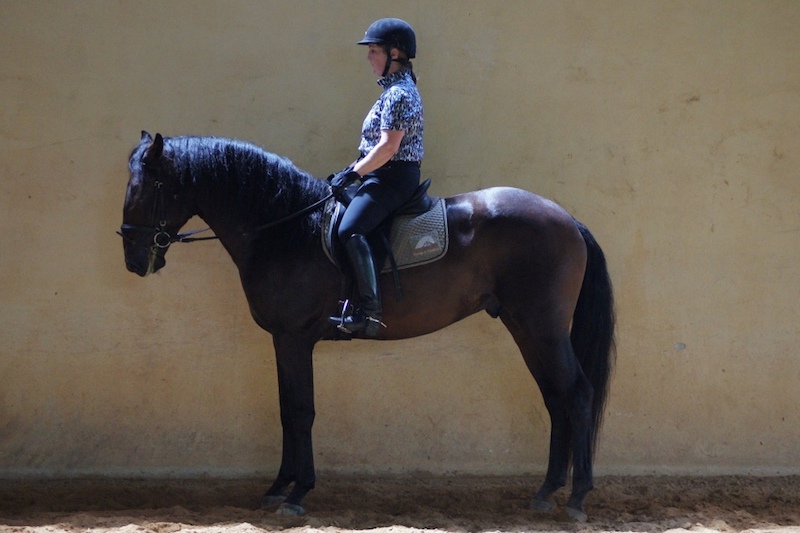6 Steps to a Good Stop
by Eleanor Blazer
Read Part 1 of this article in the September 2017 Northwest Horse Source Online Edition www.coloradohorsesource.com/september-2017-digital-edition

The most important cue for any horse being ridden is the cue to stop, or “whoa”. A good foundation should have been laid during halter breaking, leading lessons, and learning how to lunge.
The first step in reinforcing the “whoa” is that there should be no movement by the horse while the rider is getting on, and once mounted, the horse should not move until given a cue. The rider must make a conscientious effort to sit on the motionless horse for a few seconds.
Teaching a horse to stop under saddle requires six actions in sequence:
- Establish the timing for the stop.
- Give the verbal command to “whoa”.
- Set the bit as a barrier to forward movement.
- Tighten the stomach muscles.
- Squeeze with both legs.
- Release the bit barrier immediately after the horse has come to a complete stop.
- Timing sets the horse up for a square halt with the hind legs up under the body. It also requires the rider to learn the footfall sequence of the horse. The rider begins the cues to stop just as the leading forefoot hits the ground. If the horse is walking or trotting, begin the cues as the forefoot corresponding to the direction of travel hits the ground. If you are moving to the left, begin the cues as the left forefoot strikes the ground
- In concert with the timing, the rider gives the verbal command to “whoa.” The command should be given in a quiet to normal voice. Don’t yell—give the command just as you would if you were leading or lunging the horse.
- A snaffle bit should be used when teaching the stop. The rider lifts either the left or right hand to set the bit as a barrier to forward movement. Most trainers lift the hand corresponding to the direction of travel—the left hand if the horse is traveling to the left. For example, lift your left hand (by simply rolling the thumb toward the left so the palm of your hand is facing up), your right hand remains steady, holding the right side of the bit in position. By lifting the hand, you are applying pressure to the left side of the horse’s mouth, at the same time elevating the head slightly, but not tipping it to the left. The horse’s head should not turn to the left or right. The slight elevating of the head encourages the horse to be light on the forehead and start shifting his weight to the hindquarters.
- While giving the verbal and bit cue, the rider tightens his or her stomach muscles. If the stomach muscles are tight, the rider cannot lean forward or backward. It is extremely important the rider does not lean his upper body backward. The upper body should remain erect so the horse is not thrown out of balance.
When the rider tightens the stomach muscles, the pelvic bones drop backward and downward putting the rider’s seat deep in the saddle. This weight shift should immediately cause the horse to tighten his loin muscles. This rounds the horse’s back and allows the hindquarters to move under the body. It is this action which creates the square balanced stop.
- The rider squeezes the horse with both legs, applying light equal pressure to encourage the horse to drive into the bit barrier. The horse should round his back upward when coming to a stop. If you don’t apply leg pressure, the horse will stop driving with the hindquarters and his back will sag.
- As soon as the horse begins to respond to the verbal and physical cues, the bit barrier must be released. Releasing the bit barrier rewards the horse for his response. The reins should not be pitched away, but should be loose enough to remove the possibility of bit pressure. If the bit barrier is held too long after the stop, the horse will be subject to severe mouth pressure and will start looking for a way to avoid the discomfort. Most of the time, a horse attempts to avoid the bit barrier by throwing his head up, down, or to one side or the other. Such behavior by the horse means the rider should immediately reassess his stopping cues and teaching techniques. It won’t be long before the horse is attempting to avoid the stopping cues rather than responding to them.
A good exercise to reinforce the stop is occasionally asking for a few back steps after stopping. The horse will start thinking “back” which will cause the back feet to come up under the body, putting him in perfect position for a balanced stop.
When it comes to “whoa” be consistent, be firm, and be safe.
© 2017
* Take the online course “Training Performance Horses”. Earn certification or work toward a Bachelor of Science degree in Equine Studies. Go to www.horsecoursesonline.com for more information.
Originally Published October 2017 Issue

Eleanor Blazer was raised training and caring for horses. She learned to ride and care for the horses her family bought and sold. Many of these horses required improved nutrition when they arrived for training. Eleanor’s experience and research has benefited both horses and horse lovers in the field of equine nutrition. An equine nutrition consultant, based in Bulverde, Texas, she keeps busy doing equine nutrition consultations, conducting seminars, and speaking to youth groups about horse care and nutrition. Eleanor is the author of the syndicated column The Way of Horses. She has more than 20 years experience helping and being a mentor to those wanting to know how to provide the very best care and nutrition for our special friend – the horse.

